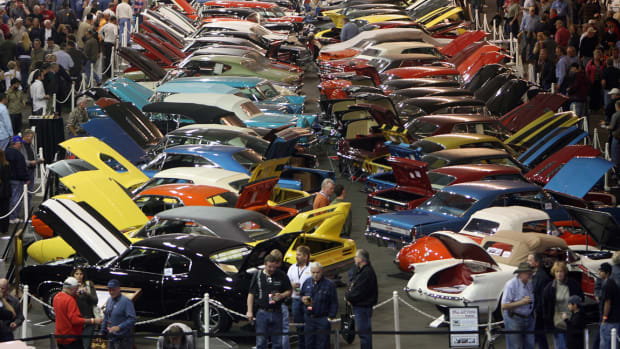A look at Earl's legacy from the inside
Story and photos by Dick Ruzzin, GM designer (retired)
There are many books and stories written by writers about Harley Earl, but none from the perspective of a car designer who worked in the design profession for 40 years, and in the environment that Earl created for those who followed him.
This is my story about Harley Earl.
Earl: An Overview
Harley J. Earl was born in 1893 in Hollywood, Calif. While he began his education at Stanford University, he left there to work with and learn from his father at the Earl Automobile Works that was founded in 1908.
The company rapidly expanded and became a popular source for custom-designed vehicles for many Hollywood stars. Eventually the shop was purchased by Cadillac dealer Don Lee, but having become known for his design work, Earl stayed on as director.
On a visit to the Don Lee Cadillac dealership, Lawrence P. Fisher, the General Manager of Cadillac, met Harley Earl and had the opportunity to observe his work.
Fisher was reportedly impressed with Earl’s techniques and his design work, offering to commission Earl to design the 1927 models of the forthcoming new LaSalle marque.
The success of the LaSalle would convince GM President Alfred P. Sloan, Jr. to create General Motors’ “Art and Colour Section” in 1927, with Harley Earl as its first director. Earl was 34 years old at the time. Thirteen years later, in 1940, Earl was named as the first Vice President of Styling at General Motors. Earl retired in 1958 and died in 1969.

Harley Earl with the “Damsels of Design” with the GM Tech Center’s stainless-steel water tower in the background.
Dick Ruzzin
Building a Place for Design
Harley Earl was a Cadillac designer before he came to Detroit. Some might ask, “What does a designer do?” Something that no lawyer or surgeon, pilot or politician can. That is, they make a convincing sketch of something that has never before been seen on earth.
Harley Earl did not sketch, but his mind was roaring with creativity, and he knew what he wanted to create and when it looked right.
When brought to Detroit, Harley Earl found a very special opportunity to use his creativity. His achievements in the industrial world are profound. He was called a “style maker” and indeed he brought style to the automobile.
But that was not his greatest achievement. The most important things that he did were to create the profession of automotive design, a studio organization and a design system, as well as a facility that has been an inspiration to the design world for years — a place created so that others could follow him and do the work of design without distraction. Harley Earl conceived and had built the General Motors Technical Center, an inspiring place for designers to create. There, designers were surrounded by a beautiful one-square-mile campus that expressed design excellence, and they were given everything needed to design.
However, the designers hardly ever looked out of the windows toward the beautiful sights of the GM Tech Center, for they were racing time every second that they were working there, as design must be done quickly so that production can begin.
The GM Tech Center was made possible by the outstandingly successful ground-breaking design work of Harley Earl and his small staff. Earl vaulted GM to the head of the American car manufacturing pack, and profits from the sale of millions of vehicles allowed management to think toward the future and to create and build a wonderful place for design, research, engineering and manufacturing.
Harley Earl had a large influence on that effort, and the GM Tech Center became an instant design and architectural icon. The famed Eliel Saarinen was contracted to design and build the Technical Center, but he passed away shortly after starting the project. His young son, Eero, took over, and Harley Earl convinced GM management to retain the company.
There is no doubt that Harley Earl’s influence on the young Saarinen was profound, as no other Saarinen project comes close to the Tech Center’s idealistic and dramatic International Style architecture that is highlighted by simplicity and beauty. The GM Technical Center is a piece of art itself with its dramatic lakes, its stainless-steel water tower and its sparkling fountains lofting high into the sky. The GM Design Dome identifies the Technical Center as a special place.
After being hired by General Motors to design its vehicles, Earl continued to develop as a designer and he hired brilliant people who brought to styling a great appreciation for automobiles, contemporary art and the Mid-Century Modern movement. If you wanted to design cars and learn from the best, then GM Styling was the only place to go. The most symbolic feature of all of this is the Design Dome, part of the secure vehicle display yard at the GM Technical Center. It is a piece of sculpture in its own right. Each building is highlighted by the specially created and dramatic-colored ceramic brick walls that identify the different staffs. A wonderful bronze sculpture created by the French artist Antoine Pevsner and named “Bird in Flight” is displayed in front of the Design Lobby.
Alexander Calder, the iconic American artist and engineer who, for the first time in world history made sculpture move, was commissioned by Harley Earl to create a dramatic fountain in front of the Research Laboratories on the north end of the Tech Center Lake. It was to be called Dancing Waters.
Calder, an American contemporary artist and engineer who was renowned around the world, came to view the fountain after its installation. On a still and warm summer evening, with a cool twilight emerging and the sun still blazing red high on the stainless-steel water tower, he was overwhelmed by the GM Technical Center’s sleek, low buildings, its colored walls and the scale of the pristine natural beauty around him. As his fountain bubbled, popped and burst into life in front of him, Calder sat down on the edge of the Tech Center Lake and he cried. He was so overwhelmed by his surroundings and the presence of his art that was part of it.
Many great car designs have been created at the GM Tech Center, and without a doubt, it remains in the global industrial world a facility with a process and a staff that is highly imitated and admired.
Now being retired and away from the GM Technical Center for more than 20 years, I see that it was an inspiration that has stayed with me, and it affects my life every single day.
It was a great gift to work there.
How lucky I was. How lucky we all were.
The Greatest Achievements
When I was working in the basement of my apartment building, hoping to be hired at GM Styling one day, I did not have the slightest thought about what would happen if I was. I assumed that I would have a desk or a drawing board of some kind. It wasn’t until years after I retired that I truly realized the significance of the GM Tech Center, the Styling building, and the people, of all kinds, who worked there.
Harley Earl created the profession of car design and a magnificent place for all those who worked there. It was an inspiring place to work. That was his intention.
There are many stories about Harley Earl, the larger-than-life designer from California with a commanding voice who was brought to Detroit by Alfred E. Sloan and given the chance to design cars for a rapidly expanding General Motors. With Sloan behind him, Harley Earl slowly earned and gained the support of GM’s army of engineers. He would go beyond cars, providing designs for the many industries in which GM took part: trains, trucks, earth-moving equipment, refrigerators and, of course, cars — all came under Harley Earl’s hand, as did World’s Fair exhibitions and even camouflage for our troops. Harley Earl imagined the future like no one else, and he was consistently right.
The first concept car, the Buick Y-Job, plus the Le Sabre, the three sensational Firebirds and many specially designed Motorama cars from GM Styling bore shapes that would influence the future of the production cars that followed for years. To accomplish a work load beyond Styling’s capability, cots were set up in the hallways so that studio staffs could sleep overnight at Styling for days on end while working very long hours. A cafeteria was put together to supply food, and the result of the intense effort to create the GM Motorama cars was the formation of a creative spirit and a way of work driven by GM Styling’s people who advanced the design process far beyond any other in the world. The influence of his leadership would last beyond Harley Earl and Bill Mitchell, his favored successor; it would last well into the 1990s, and it is still an influence today.
When Harley Earl arrived in Detroit, he probably only had a few drafting tools. He had to look for helpers as car design as a profession did not yet exist. Yet he was soon able to start affecting the chaotic GM collection of companies, and eventually he would be the main influence in the building of the colossal GM Technical Center and establish a Styling Staff that would become the jewel in the crown of General Motors.
Harley Earl looked everywhere to find talented people qualified to join his growing staff. Very few existed. Some came from universities, body shops, paper factories, stove works — they all worked together and learned how to create and design under his direction.
The GM Motorama cars were designed in an unprecedented rush by a small group of people after World War II, and the advancing experience would carry them ahead of the auto industry for years. They were the ones who slept on the cots in the hallways. From cars to kitchens and cities on the moon, GM Styling showed what the world would be like tomorrow and beyond.
Professional industrial styling as a career had been essentially created by Harley Earl, and by the early 1960s, the bar in this career field had been raised to a very high standard at GM. The entire automotive industry in America, Europe and Asia had benefit from Harley Earl’s ambition and achievements. There were now many trained designers who hoped to work under people such as Harley Earl. When I had my interview at GM in 1962, I was told to prepare for disappointment as only one in 200 applicants at Styling had the right qualifications to be hired. The bar had been raised to that high of a standard.
Harley Earl’s studio system was developed first with designers, and then engineers were quickly added for technical support of the studio designs. Modelers from the plaster and wood shops finally came to shape the clay models. The modelers were gradually replaced by sculptors with degrees in Fine Arts, and as the studio teams grew with talent and experience, they became a fluid and dynamic creative force. Wonderful creative processes were developed and then quickly passed from studio to studio. That highly motivated combination of professionals has sustained the design effort at General Motors for almost 100 years.
When he was hired at GM, Harley Earl had to fight hard to get work from the engineers responsible for vehicle development. It was not until he showed the corporation how to create common body shells with different divisional identities that he was able to gain design control by giving different design personalities to Chevrolet, Pontiac, Oldsmobile, Buick and Cadillac. Each was given a unique design identity that has continually evolved through the years.
GM Styling’s evolving design processes continually improved, and they would be embraced by auto designers around the world. Harley Earl invented the clay model while still working at his father’s coachbuilding company in California, and he brought the new form of three-dimensional visualization to General Motors in Detroit. The clay model would come to be used by every car design staff in the world, as it is even today.
New designers at GM entered a world that was very unique and, at the same time, representative of the new and growing rough-and-tumble industrial work force in America. Those first hired loved cars, but they had to learn to be artists and designers while working on the job as they invented the profession of automobile design. After World War II, college-educated designers were new to the car design business and they brought artistic techniques, speed and presentation skills that the early designers did not have. Their enthusiasm and drive advanced the design processes even further.
Through Harley Earl’s growing influence, GM Styling was to become complete with everything necessary to do the work under one roof, as was the case at the Bauhaus in Germany and the Cecil B. Demille movie studios in Hollywood, where his father had worked. By Harley Earl’s dictate, the Styling designers would effectively have complete control over the creative process, and they were provided with everything to do the work from beginning to end, all in one place and all under one roof. GM Styling, later to be called Design, would become the largest full-functioning design organization in the world.
GM Styling had a complete complement of shops, as organized by Harley Earl. Large special shops, fully equipped, were created for paint, plaster, metal, wood, mechanical and interior trim and, when it came along in the early 1950s, fiberglass. The shops could build anything that the designers could create from wood templates to full-size interior and exterior models that looked convincingly like real cars. It was Harley Earl’s special achievement to develop such a massive industrial design system, but the most outstanding part of it was not the place, it was the people whom he hired.
The choice of the people and the continuing high professional standards were the greatest gifts that Harley Earl gave to GM and to all those who followed him in his place.
Well-staffed by many young Americans as well as immigrant artisans, the shops had people from Italy, Poland, England, Germany, Lithuania and many other Old World countries. Most had hands-on artistic and mechanical skills that made them special and perfect for helping to visualize in three dimensions the dreams of the in-house Harley Earl designers.
In all of the world there was nothing like it.
The huge rooms of the shops — some with soaring ceilings and cranes high above — had the smells and sounds of things being made by hand and were different than the design studios that had the sweet odor of sulfur, an ingredient in the modeling clay that was used by the sculptors to create the car design proposals in full-size and in three dimensions.
Like five rivers flowing, the designs were created in the studios, recorded on the drawing boards and then built in the shops. The clay models would be cast, filed, sanded, painted and finally rolled out in front of the GM management team for approval, and then go on to be tooled, tested and produced. The highly focused creative forces that Earl unleashed would make GM the global leader in vehicle production and provide the funds for the creation of the iconic GM Tech Center.
Earl: An Epilogue
Harley Earl was competitive, even as a young man. He borrowed his father’s Stutz on a Sunday morning and, without telling him, went to a California racetrack. He raced, and he won!
It wasn’t until later reading a newspaper that his father learned about young Harley’s racing adventure.
Yes, like many of the American auto giants, Earl was a racer, too. But he was a different kind of racer. He raced time to bring beauty to the American automobile, and he inspired many others to also take on that challenge. He brought beautiful automobiles to all of us for years, and by the millions!
If you like stories like these and other classic car features, check out Old Cars magazine. CLICK HERE to subscribe.
Want a taste of Old Cars magazine first? Sign up for our weekly e-newsletter and get a FREE complimentary digital issue download of our print magazine.

















